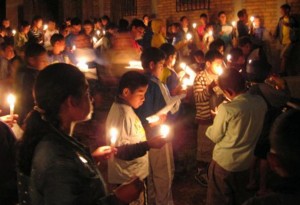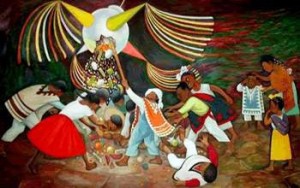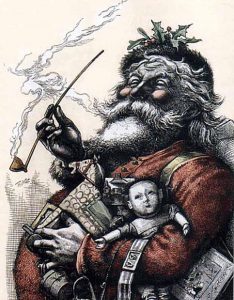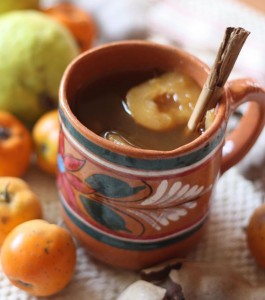The origins of Christmas traditions
Wonder where some traditions like the Piñatas or the Posadas come from? Here is a very basic and simple list of those Christmas traditions, including some holiday drinks.
The Poinsettia: The favorite plant for the holidays
Poinsettias are part off all Christmas celebrations.
This is a case of “stolen identity” because this plant (read: the red petals you see are actually leaves–the poinsettia flower is the yellow part you see in the middle of those red leaves) was brought from Mexico to United States and renamed by Joel R. Poinsett, the first US envoy to Mexico.
Poinsett (1779-1851), a physician and diplomat, held several offices in the country and besides the plant, several places in the East Coast carry his name: A lake, a highway, a county, a bridge. He was a Minister to Mexico between 1825 and 1830.
According to some reports, he “discovered” the shrub called Christmas Eve, or Cuetlaxochitl by the Aztecs, in Taxco. He later brought some samples to the USA, renamed it and made it popular.
This red and green leaves blooms in winter and it’s also popular in Central America. The Aztecs used it as red dye and pain reliever. Its association with Christmas came in the 16th century as part of the Catholic Church’s efforts to control all aspects of indigenous cultural life.
The story, created by Catholic priests, talks about a young girl willing to make Jesus a present for Christmas, but she was very poor. Inspired by an angel, the girl collected seeds and planted them in front of Christ’s image. Later, beautiful red and green flowers bloomed, and that’s how the legend of the “Flor de Nochebuena” was born.
The Posadas

The festivities are in full swing with the beginning of the posadas.
The Posada (or lodging) is a reenactment of the Virgin Mary and Joseph asking for a place where she could give birth to her son Jesus.
According to the Christian tradition, Mary and Joseph traveled from Nazareth to Belen, where Jesus was born. They asked several people for lodging, but they refused until somebody accepted them.
Of course, the representation varies according to time and place. However two elements are almost untouched: The main song and the length —this is played for nine days. Each reenactment is short, and most of the time participants have candles while going from one house to the other.
The song is basically a dialogue between the travelers and the people inside the houses that they visit. Once Mary and Joseph are accepted, the song becomes more festive and there is a celebration.
At the end, in most cases there is a piñata for children and people drink either “champurrado,” hot chocolate or ponche.
This tradition was brought from Spain to Mexico where it’s very popular to this day. It’s also celebrated in Guatemala and parts of the Southwestern U.S. due to the Mexican cultural influence.
The Piñata: Another Christmas tradition with a Hispanic accent.

Piñatas are known to liven up any Christmas celebration.
Basically, a piñata is a container —made of colorful pottery, cloth, or papiermaché— filled with candies and/or small toys. It’s not just for Christmas, but also other celebrations, especially birthday parties.
Hung from above on a string, the piñata is hit by participants at the party until it breaks, the candies and toys falling on the floor while people run to get the treats.
In certain Mexican areas, piñatas are filled with peanuts and small mandarins. This was a tradition used by Catholic priests in the early times of the Conquista to co-op local traditions, a perfect blend of European and indigenous customs.
Catholic priests brought this tradition from Spain, however the word comes from the italian “pignatta.” And to make it more intriguing, some historians tracked down similar traditions in China and other countries.
However, the Aztecs already had a similar tradition to celebrate “Huitzilopochtli,” —the War God— in December.
The piñatas are a commercial success and people can buy them almost in any Hispanic supermarket around the US, particularly in the Southwest. Nevertheless, some families prefer to make their own piñatas, having children be part of the process; others prefer to purchase more elaborate and artistic piñatas that are commercially made.
Santa Claus, Papa Noel or Viejito Pascuero?

Christmas tradition and the origin of Santa Claus.
This is not a Hispanic tradition, but without a doubt it’s the most popular character of the Holidays.
There are several interpretations about the origin of Santa Claus —and many songs too. In this regard, we can mention “Santa Claus is coming to town,” written by John Coots and Haven Gillespie in 1934, as the most popular of all.
Over the years, the image of Santa Claus changed, but since the first part of the 20th century, tradition established that he lives in the North Pole, he has a large white beard and white hair; he is chubby and is always jolly.
On Christmas night, Santa delivers presents to all children. Well, not all of them since the main condition to be on his list is to be a well behaved child. Santa travels around the world on his magic sledge and carries a big bag with presents.
Apparently, the figure of Santa comes from the Greek priest Saint Nicholas, of Myra. He lived in the third century and was known as a generous person.
Based on this model, with the addition of local traditions and folkloric narrative, the image of Santa Claus became well establish in Europe around the 19th century, passing later to USA and Canada, and expanding later to the rest of the continent.
As the image of Santa Claus traveled South, his name also changed, becoming Papa Noel in most Latin-American countries and Viejito Pascuero in Chile.
Today most people don’t think much about the origins of this tradition, and Santa Claus impersonators can be seen in most shopping centers in the Americas.
Traditional Christmas drinks
Christmas traditions and Mexican champurrado
Its a thick indigenous drink made of corn dough and chocolate. There are many versions of this drink. But regardless what recipe you use, champurrado will keep you warm and will give you energy —naturally.
One basic recipe call for simmer milk, piloncillo (a dark-brown unrefined cane sugar, used to replace sugar) and chocolate.
You can also add cinnamon. Mix the corn dough with water (or milk) and add it to the simmering milk. After 10 or more minutes its ready.
Since this is a very thick drink, it keeps its temperature, which is one of the reason to be considered a “winter drink.” The ingredients to make champurrado can be organic, making this drink a natural favorite.
Hot chocolate
To drink chocolate is another indigenous tradition. It’s said the Mayan loved this “potion.” Is very simple to make hot chocolate these days by using powder chocolate, mixed with hot milk or water.
However, the real thing calls for melting a chocolate bar and mixing it with sugar or piloncillo. Most Mexican or Hispanic grocery stores carry this type of chocolate.

Ponche
Ponche Navideño: Traditional Mexican Christmas punch
It’s a warm fruit punch and it also has several variations. Nobody knows where this concept started. Apparently Spaniards brought to Mexico, a raw idea about the ponche.
The idea is to mix fruits in a pan with boiling water, plus piloncillo and cinnamon. You can use the fruits of your choice but basically oranges, apples, tejocotes guavas and a piece of sugar cane. A real ponche includes other ingredients, like tamarindo, prunes, raising, etc.
The ponche is ready when the fruits are tender. Children love it and adults sometimes incorporate a little bit of rum or brandy and tequila. This recipe is easy to make and in some grocery stores there are some “ponche kits” available.
Reprinted from VOXXI (http://voxxi.com/)





